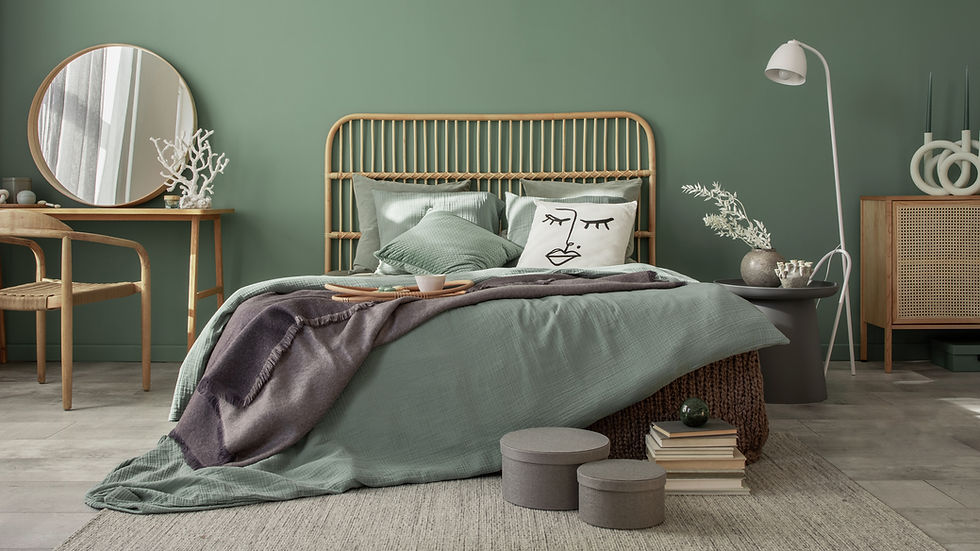Sustainable Living: Aligning Mindfulness with Eco-Friendly Choices
- Tania Antoinette
- Jan 3
- 3 min read
The worlds of mindfulness and sustainability converge in a powerful way, offering us the opportunity to create homes that nurture both our well-being and the planet. Sustainable living isn’t just about reducing waste or conserving resources, it’s a lifestyle shift that embodies mindfulness, intentionality, and responsibility. Today we will explore how eco-friendly choices can enhance your home while aligning with your values.

The Intersection of Mindful and Sustainable Design
Mindful design focuses on creating spaces that promote awareness, calm, and intentional living. Sustainable design, on the other hand, prioritizes materials and practices that reduce environmental impact. Together, these philosophies create a harmonious approach to living, where every design decision reflects a commitment to self-care and care for the Earth.
Imagine a home that not only feels good to live in but also contributes to a healthier planet. From the materials you choose to the way you use resources, embracing this synergy can transform your living space into a sanctuary of sustainability and mindfulness.
Eco-Friendly Materials for Mindful Living
Choosing sustainable materials is a cornerstone of eco-conscious design. Here are a few to consider:
1. Bamboo
Bamboo is a rapidly renewable resource that’s both durable and versatile. From flooring to furniture, bamboo adds a natural aesthetic while minimizing environmental impact.
2. Recycled Furniture
Opting for pre-loved or recycled furniture reduces waste and adds character to your space. Vintage or refurbished pieces often come with a story, creating a unique and meaningful environment.
3. Natural Textiles
Incorporate organic cotton, linen, or hemp for upholstery, curtains, and bedding. These materials are free from harmful chemicals and align with sustainable farming practices.
4. Low-VOC Paints
Traditional paints release volatile organic compounds (VOCs) that can harm indoor air quality. Choose low-VOC or no-VOC paints to keep your home’s environment safe and healthy.

Tips for Water and Energy Efficiency
Small design changes can lead to significant savings and a reduced ecological footprint. Here’s how:
Water Efficiency
Low-Flow Fixtures: Install low-flow faucets, showerheads, and toilets to reduce water usage without sacrificing functionality.
Greywater Systems: Consider systems that reuse water from sinks and showers for irrigation or other non-potable uses.
Rainwater Harvesting: Collect rainwater for gardening or cleaning purposes.
Energy Efficiency
LED Lighting: Replace traditional bulbs with energy-efficient LED lights, which consume less electricity and last longer.
Smart Thermostats: Use technology to optimize heating and cooling, reducing energy consumption.
Solar Panels: If feasible, invest in solar panels to harness renewable energy and lower your carbon footprint.

Mindful Consumerism: Choosing Decor and Furniture Wisely
Mindful consumerism is about making intentional choices that reflect your values and contribute to a sustainable future. Here’s how to approach it:
1. Buy Less, Choose Well
Focus on quality over quantity. Invest in timeless, durable pieces that align with your aesthetic and can stand the test of time. Pro Tip: Furniture consignment stores are a great place to purchase gently used designer furniture for much less than retail.
2. Support Ethical Brands
Research companies that prioritize fair labor practices, sustainability, and transparency. Supporting these brands amplifies their positive impact.
3. Think Local
Buying locally reduces the carbon footprint associated with shipping and supports artisans and businesses in your community.
4. Repurpose and DIY
Get creative with what you already have. Repurpose old items or tackle DIY projects to breathe new life into your space without unnecessary purchases.

Living Sustainably with Intention
Sustainable living is not about perfection; it’s about progress. By aligning mindfulness with eco-friendly choices, you can create a home that reflects your values and fosters well-being. Every step, no matter how small, makes a difference, contributing to a future where mindful and sustainable design go hand in hand.
Are you ready to embrace the power of mindful sustainability? Let’s reimagine how we design our homes to benefit both our lives and our planet. Share your thoughts and tips in the comments below, or explore more ideas for mindful living on the website!
Comments